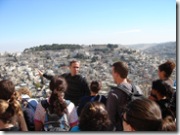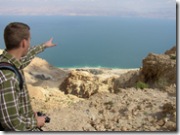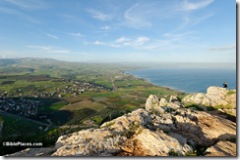I like a good calendar, especially one with photos of Israel. But while the title of this one is intriguing, the cover shot just does not inspire me. Maybe the rest of the shots that you can’t see are better! At $18, I’m not risking it. But you can see the “Jerusalem in the Fog” calendar and decide for yourself.
The tomb of the Apostle Paul was allegedly discovered a couple of years ago and now there are reports that Pope Benedict XVI has given permission for the tomb to be opened. Apparently an endoscopic probe will be put through a hole in the tomb in order to transmit images. There doesn’t seem to be much online about this yet, but you can see this blog and WorldNetDaily for more.
- Tagged Discoveries
The newly discovered church at Shiloh was discussed on this blog last December, but Israel Today has a little blurb online with some details I unaware of. The full story is available only by subscription to the print magazine, but this much is online:
The floor of the worship sanctuary is decorated with brightly colored mosaics and many of the inscriptions refer to Yeshua (Jesus). The original church was built in 380 AD. It was probably destroyed by a flood and later replaced by a new building, based on information gleaned from the inscriptions. Aharonovitch says one of the inscriptions is particularly unusual as it mentions the name Shiloh: “Lord Jesus Christ, have mercy on Seilun [Shiloh] and its inhabitants, Amen.” “This is very rare and indicates that the early Christians revered this place as a holy shrine,” Aharonovitch said.
I don’t see anything else online with more details than were initially reported.
I taught my first college-level tours in Israel when I was 21, and for the past 14 years, I have led many student groups of various shapes and sizes. Here are some suggestions that I believe make for a better tour of Israel, with varying applicability depending upon the group.
1. Do the more mentally challenging sites in the morning. Students are more ready to learn when they are less tired. For instance, if you’re visiting the sites north of the Sea of Galilee, I think it’s better to go to Hazor and Dan in the morning and drive across the Golan Heights in the afternoon.
2.  Whenever possible, keep subject-related sites together. For instance, in the Galilee area, I find it best to group the sites related to the life of Christ together on a single day. This is preferable to bouncing back and forth between various periods. This is not always possible, as, for instance, it isn’t practical to visit En Gedi (more OT-related) and Masada (more NT-related) on different days.
Whenever possible, keep subject-related sites together. For instance, in the Galilee area, I find it best to group the sites related to the life of Christ together on a single day. This is preferable to bouncing back and forth between various periods. This is not always possible, as, for instance, it isn’t practical to visit En Gedi (more OT-related) and Masada (more NT-related) on different days.
3. Always prepare the group. Surprises are usually bad. Warn them the day before if the next day is going to be especially physical, or particularly late, or generally boring. Almost more important than reality are the expectations. I can almost make a lame site good just by thoroughly disparaging it in advance!
4. Don’t talk too much. If you do, they won’t hear what is important. The goal is not to show off how much you know but to help them understand.
5. Sometimes less is more. It might be better for the group to skip a site than to squeeze it in. It may be better for you to skip an explanation than to give it.
6. Skip more impressive (non-biblical) remains in favor of a less impressive site with a biblical story. I’ll skip Beth Shearim, but never Tel Jezreel. I’ll skip Sepphoris, but not Nazareth. I’ll skip Avdat, but not Arad.
7. Read the Bible where it happened. Don’t skip this for your explanation. You can’t always read every biblical story on site, but it is better to err on the side of too many than not enough.

8. Don’t be afraid to confess ignorance. If you pretend you know and are then shown to be in error, you lose credibility. If you don’t have credibility, you’re just a chauffeur.
9. Lunch breaks are for eating. When you’re done eating, get moving.
10. Do what the group does, even if you’ve done it a hundred times and hate it. If you skip walking through Hezekiah’s tunnel, or you skip watching the Qumran video, it communicates that this is your job and not your passion.
11. Try hard. They’ll see it and they’ll follow your example.
12. Leave on time. If everyone is not there, leave anyway. If you don’t, they learn that deadlines don’t matter and within a week, you’ll consistently be 15 minutes (or more) late leaving everywhere. And then you miss cool things or won’t be able to do #7.
13. Wait for the group. When you’re at a site, wait until everyone catches up before beginning the explanation. This communicates that what you say is important, and it reduces the number of questions about the things you already said.
14. Give them time to take pictures after the explanation. If you don’t, they’ll take pictures when you’re teaching and they won’t be listening.
15. Love what you do. For me this means not giving tour after tour after tour. If I do, I am not excited anymore. Many tour guides are boring because they are bored. And no wonder, when they do the same tired itinerary week after week.
16. Different guides have different priorities that define the day. Here are some of mine:
- The first view of the Sea of Galilee is from Arbel, always in the afternoon. This creates a lasting memory.

- Take a boat ride on the Sea of Galilee in the afternoon. This is a good change of pace, and afternoons need changes of pace more than mornings. In the summer, it’s a refreshing break from the heat.
- Visit Mount Carmel (Muhraqa) in the afternoon. It is one of the top three views in the country and there is often poor visibility in the morning.
- I never skip the Cove of the Sower, even though it’s become more difficult over the years. There’s less traffic early in the morning.
- I like to visit Cave 1 at Qumran, especially since very few people know where it is.
- Tagged Travels
The Biblical Archaeology Society is having a summer sale on DVDs that looks pretty good. For instance, the BAS Lecture Series Deluxe Set I is $80 and includes 9 DVDs with 15 lectures. Some of the lecturers are leaders in the field, including William G. Dever, Michael D. Coogan, Bart Ehrman, James Tabor, Aren Maier, and Shelley Wachsman. A bonus lecture by Dever includes his personal memories of famous archaeologists. I haven’t seen these, but good lecture series usually require a plane ticket and an entrance fee of $25 and up. There’s a second series for $62 which includes 12 lectures. Some of the topics seem a bit esoteric, and some of the lectures I don’t think you’d want to show to a church group, but for many who can’t go to grad school, this is one option.
- Tagged Resources
I have been alerted to a couple of articles related to Paul’s shipwreck on Malta. These are largely in response to a recent popular theory by Robert Cornuke. According to the author, Mark Gatt:
My greatest concern now is a relatively new thesis that the shipwreck occurred on the Munxar reef near Marsascala. Just because 4 or 6 roman anchors were found near the Munxar reef, a myth has been fabricated claiming a completely different site and totally ignoring our traditions. In his book The Lost Shipwreck of Paul, Robert Cornuke has traced the finding of such roman anchors and has unconvincingly created this myth. I have no archaeological or scholastic pretences, I am an avid scuba diver and my knowledge is limited to these islands, both above and below sea level, local tradition and The Acts of The Apostles. With this limited arsenal of knowledge I shall attempt to rebut the cause for Munxar as described in this book.
The articles are:
St. Paul’s Lost Shipwreck: Has the site been truly discovered?
Lead Anchor Stock Discovered: Could this anchor have come from St. Paul’s Shipwreck?
Search
About the BiblePlaces Blog
The BiblePlaces Blog provides updates and analysis of the latest in biblical archaeology, history, and geography. Unless otherwise noted, the posts are written by Todd Bolen, PhD, Professor of Biblical Studies at The Master’s University.
Subscribe
Tags
10th Century
American Colony Photos
Analysis
Antiquities Trade
Dead Sea
Dead Sea Scrolls
Discoveries
Egypt
Excavations
Forgery
Galilee
Greece
Holidays
Israel's Coast
Italy
Jerusalem
Jezreel Valley
Jordan
Jordan Rift
Judah
Lebanon
Lectures
Mediterranean Islands
Mesopotamia
Museums
Negev
New Exhibits
Persia
Philistines
Photo Resources
Picture of the Week
Pseudo-Archaeology
Resources
Sad News
Samaria
Shephelah
Syria
Technology
Temple Mount
Tomb of Jesus
Tourism
Travels
Turkey
Weather
Weekend Roundup
Links
Notice
As an Amazon Associate we earn from qualifying purchases. In any case, we will provide honest advice.
